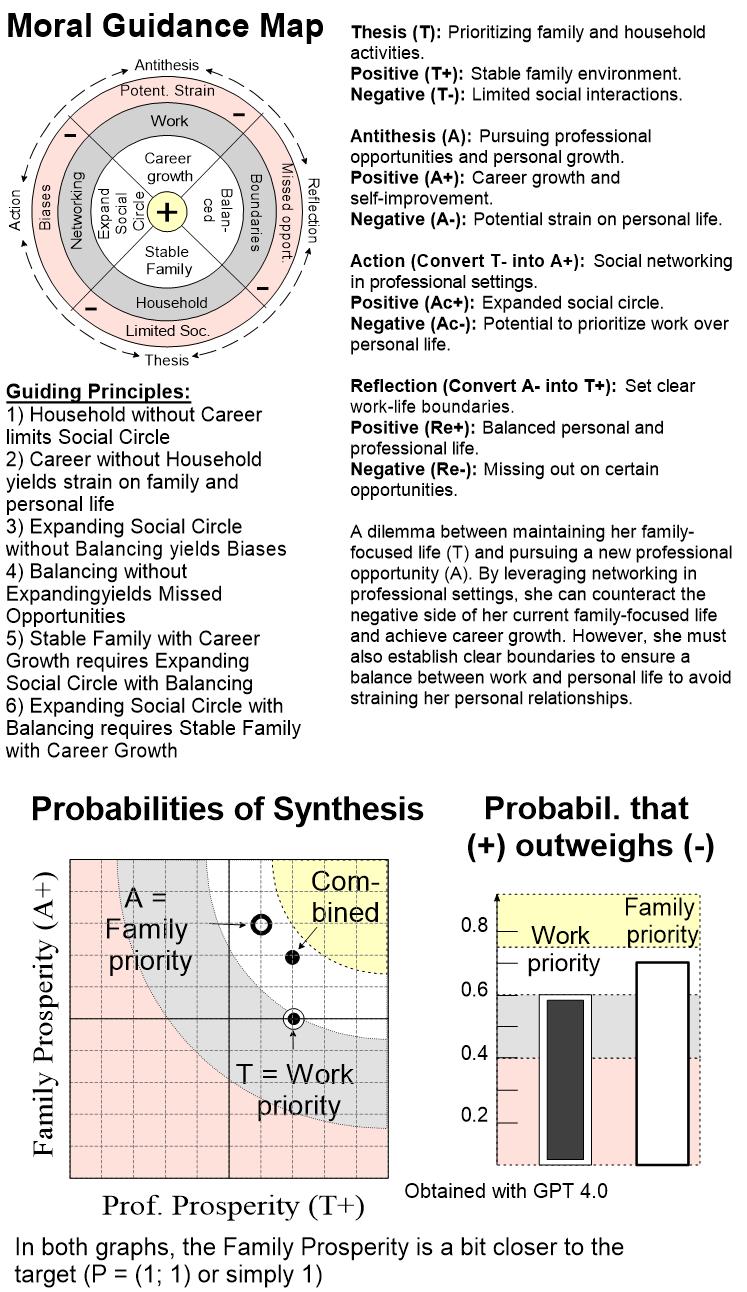
Example of a multistep analysis of a Family vs. Work dilemma
Exemplified Steps:
1) Characters, advices, inspirations
2) Guidance Maps and Probabilities
3) Refined suggestions
1. Characters, Advices, Inspirations
Wife’s traits: Responsible (as she’s dedicated time to her child and household), Aspirational (wants to make a name for herself), Reflective (analyzing pros and cons of the situation), Lacking confidence, Indecisive, Fears overextension (worries the job will drain her energy). MBTI Type – ISFJ (The Defender): Typically seen as protectors and nurturers but can sometimes be hesitant to move outside their comfort zone.
Actions/Reflections for Change:
Seek Mentorship: Engaging with someone who’s been in a similar situation could offer guidance. Time Management: Setting clear boundaries between work and personal time can ensure neither sphere is neglected.
Self-confidence Exercises: Regular affirmations and recollections of past successes can boost confidence.
Dialectical Push-Pull Mechanism: To combat the lack of confidence and fear of overextension, she could start the job on a part-time or trial basis. This way, she gets exposure without being fully committed, allowing her to gauge her capacity and interest.
Wise Saying: “Opportunities don’t often come along. So, when they do, you have to grab them.” – Audrey Hepburn
Biomimicry: Bamboo: On the outside, bamboo is tougher than steel, but inside, it’s hollow. This represents resilience on the outside while allowing for flexibility and growth on the inside.
Historic, Epic, or Literature Figure: Hildegard of Bingen: A medieval polymath who delved into various fields while also fulfilling her religious duties, she’s a testament to pursuing varied interests successfully.
Videoclip/Music: “I Was Here” by Beyoncé: A song about making a mark and leaving a legacy.
Bitter Example to Inspire Change: A person who had several opportunities to step outside their comfort zone but never did, only to later realize that they missed out on experiences that could have brought growth, happiness, or fulfillment. This person lives with regret and wonders what could have been.

2. Guidance and Probabilities
The figure on the right displays the “moral guidance map” which highlights top advantages and risks in a single scheme. It features six “guiding principles” that aid in steering towards a favorable outcome.
The bottom graphs present the likelihood that the stated thesis and antithesis align with each other’s positive outcomes, leading to a preferable future, and that their advantages surpass their drawbacks (based on GPT 4.0 estimations). In both cases, the Family Prosperity is a bit closer to the target (P = (1; 1) or simply 1)
3. Refined Suggestions
These recommendations stem from repeated inquiries regarding the strengths, weaknesses, and potential collaboration between opposing parties. While much of this information may echo previously mentioned points, there could be new insights that are valuable.
Desire for Professional Growth:
Positive Traits: Ambitious, Aspirational, Independent
Negative Traits: Uncertain, Fearful, Overwhelmed by Choices
Prioritizing Personal and Family Well-being:
Positive Traits: Family-Oriented, Caring, Nurturing
Negative Traits: Risk-Averse, Socially Isolated, Dependent on Comfort Zone
Dialectical Push-Pull Mechanisms:
A) Use the Ambition of the First Side to Overcome the Risk-Aversion of the Second: By acknowledging her aspiration to grow professionally, she can use this drive to take calculated risks and come out of her comfort zone, allowing her to strike a balance between work and personal life.
Advice: “Fortune favors the bold.”
Biomimicry Association: Just as a tree reaches for sunlight and grows while keeping its roots firmly in the ground, she can grow professionally while remaining grounded in her personal life.
MBTI Type: ENTJ (The Commander)
Historic Figure: Amelia Earhart – pioneering her own path despite challenges.
Videoclip/Music: “Roar” by Katy Perry – symbolizing empowerment and overcoming fears.
Bitter Example: Missing out on a life-changing opportunity due to indecision or fear.
B) Leverage the Nurturing Aspect of the Second Side to Address the Overwhelm of the First: Understanding that she can bring her nurturing and caring nature into her professional space can make the transition smoother, allowing her to blend her two worlds without losing her essence.
Advice: “Do what you love, and you’ll never work a day in your life.”
Association: A river that carves its path through landscapes but nourishes the lands it touches.
MBTI Type: ISFJ (The Defender)
Historic Figure: Mother Teresa – seamlessly blending nurturing with her mission.
Videoclip/Music: “Wind Beneath My Wings” by Bette Midler – honoring those who support and uplift us.
Bitter Example: Staying in a comfort zone, leading to stagnation and regret.
The “push-pull” strategy here aims to use the strengths of each side to address the weaknesses of the other. By seeing the potential synergies between her desire for growth and her nurturing nature, she can navigate her dilemma in a more holistic manner.
Family vs. Work (Quick Analysis)
Family vs Work – Alignment with Rules of Life
Family vs. Work – Character Profiling

